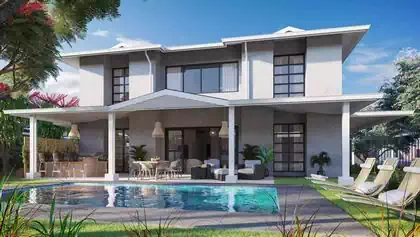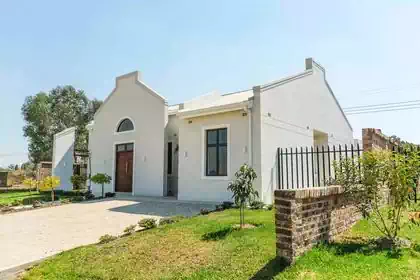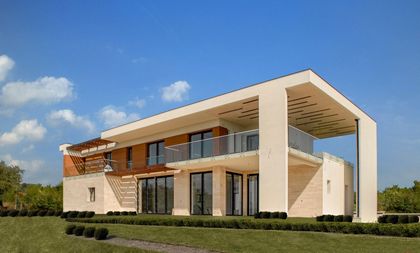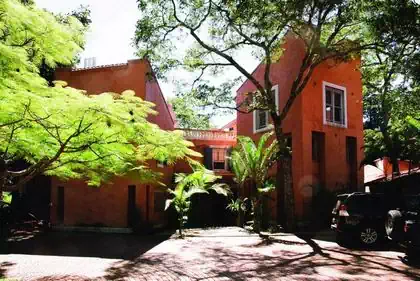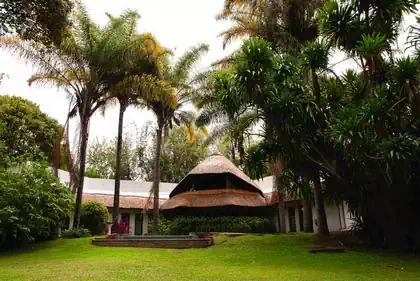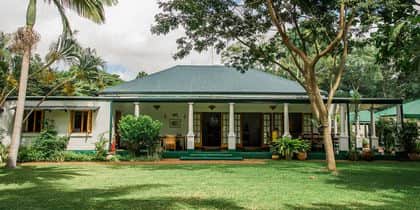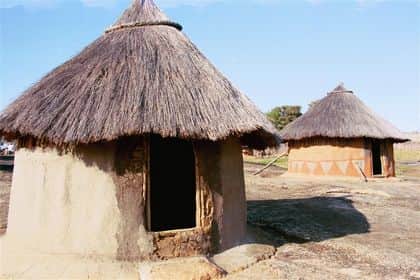Residential architectures of Zimbabwe
Zimbabwe's urban landscape is changing rapidly and new houses, flats, and cluster developments are springing up all over. Since building your own home is deemed a human right in Zimbabwe, and if under 400m2 anyone can submit residential house plans for approval. They only have to follow the building by-laws so that they are stable, healthy structures fit to be lived in.
Many developers in the market building cluster developments, and stand-alone villas provide a variety of architectural styles. The predominant residential architectures can be classified into the following categories:
Contemporary houses
A currently popular architectural style for houses in Harare that draws heavy inspiration from South African and Australian houses. It is recognizable by the hip and valley roof and sometimes the dutch gable meaning the louvred side openings in the roof for ventilation and light. The windows are large, often with plastered surrounds. The colours are usually subdued, mostly in the greys and beige tonalities with the window surrounds in white or a lighter version of the main colour.
The living areas usually have a high volume with exposed timber roof trusses and a tongue and groove ceiling painted in white. A covered veranda can be present branching off from the living room. Usually cool and well adapted to our climate due to the high volumes and windows shaded by the roof overhangs, and the natural roof ventilation.
Cape Dutch mansion
Inspired by the old Afrikaner architecture of the Western Cape in South Africa, it used to be associated with the early Dutch settlers. The presence of large ornately decorated gable walls ( wall at the end of the roof), thatch roofs, external timber shutters, cottage pane windows, white walls, and elements of green is characteristic. The style has been modernized and some of the features have been reduced or lost, but the gable walls continue to be the salient feature. The colours are muting from whites to light tones of grey, beige, and peach.
Exposed trusses can be present inside as well as suspended ceilings and the original longitudinal layout has been modified to current arrangements for smaller plots. Wooden pergolas and shutters used to provide shade and protection to the windows, but have mostly been lost in the current designs.
Modern villa
Also a very popular house style, it is characterized by straight lines and boxy shapes. Wide beams and columns are emphasized and exaggerated in the space around the house for aesthetic purposes too. The roofs are usually flat concrete slabs or hidden low pitch hipped roofs. Large vertical and horizontal windows dominate the facades together with glass balustrading. Usually, they are two-story high. Greys and beiges are the go-to colours.
A double-height entrance links to the living areas and upstairs bedrooms. While usually impressive in size these house designs tend to have little consideration for sun penetration and the large windows allow abundant direct sunlight to overheat the internal spaces.
Mediterranean villa
An import from the south of Europe, the Mediterranean, and especially Tuscan architecture is widely recognizable and loved. Rhythm in windows and doors, proportions, and a sense of scale are always present in this architectural style. Plastered window surrounds, quoins ( cornerstones), external wooden shutters, wrought iron, and stone details are common features. Tiled hipped roofs and gutters are usually tinted in terracotta and peach colours like the external walls.
The windows are typically smaller and the internal spaces with lower ceilings creating cool, intimate rooms. Wooden or tiled floors in similar warm colours are known.
Thatch homes
Evolving from the traditional hut architecture, the thatched roof houses are steadily losing popularity in Zimbabwe. Associated with curved walls and organic forms, the houses feel more natural than their counterparts. The steep thatched roof usually has decorations implemented in the roof and dormer windows help bring in light to the higher spaces. The pitch of the roof has to be 45 degrees leading to high roofs that are therefore large and dominating in respect to the walls. Usually, the colours are earthy, natural, and tied to the thatch and gum pole colours.
Internally the triple height of the thatch roofs creates a cool, large space that can be slightly dark and musky. The interiors feel organic and the contact with nature is overwhelming. The houses usually have cool, quiet ambients.
Minimalist house
Similar to the modern Zimbabwean houses they are usually rectangular in shape and look. There is a distinct lack of detail in the facade and elements in space, and the forms are clean and precise. The roofs are flat concrete slabs and the gutters are hidden, minimizing the details present. Openings and window sizes can vary, but always have sleek, clean lines and minimal frills. The presence of structural challenges is common too, like cantilevered balconies, roofs seemingly magically floating, etc. The tones are white or monochromatic.
The interior spaces are characterized by open-plan configurations leading to wide, luxurious spaces usually of increased internal height. Overhangs, louvres, and detailed climate considerations are mostly present.
Rhodesian houses
Remnants of past times and material availability, these houses are seldom built but are present within Zimbabweans urban landscape. Well adapted to our local climate the architectural features are mostly functional aiming to control the ever-present beating sun and rain. A wrap-around lean-to veranda usually surrounds the house, providing shade to the internal spaces, and an external place to spend the day without being exposed to the scorching sun.
The steeply pitched tin roof over the main house with a lower pitch over the veranda are interrupted with dormer openings with louvres that provide natural ventilation into the roof space, cooling it. Wrought-iron columns with intricate decorations usually carry the lean-to roof over the veranda. The cottage-pane windows are small and sheltered from direct sunlight with the exception of an occasional gable wall with bow windows. The internal rooms are cool, with low ceilings creating a sense of intimacy and ease.
Traditional huts
Outside cities, traditional round huts made out of wooden poles filled with clay and conical thatched roofs were the norm. They were arranged in a circle around a central courtyard with the kitchen and sleeping zone in different huts. The mud walls were occasionally decorated with geometric shapes, and have now been replaced with sun-dried bricks, tin roofs, rectangular floor plans and more windows.
However, the traditional hut cannot be viewed outside its social sense of the village and interaction with the other participants of the community. Thus the hut is only a part of the whole that should be viewed holistically.
Address
2.99 Hobourne Hill
Borrowdale
Harare, Zimbabwe
Contacts
Email: info@panarch.info
Phone: +263 (24) 2870 232



